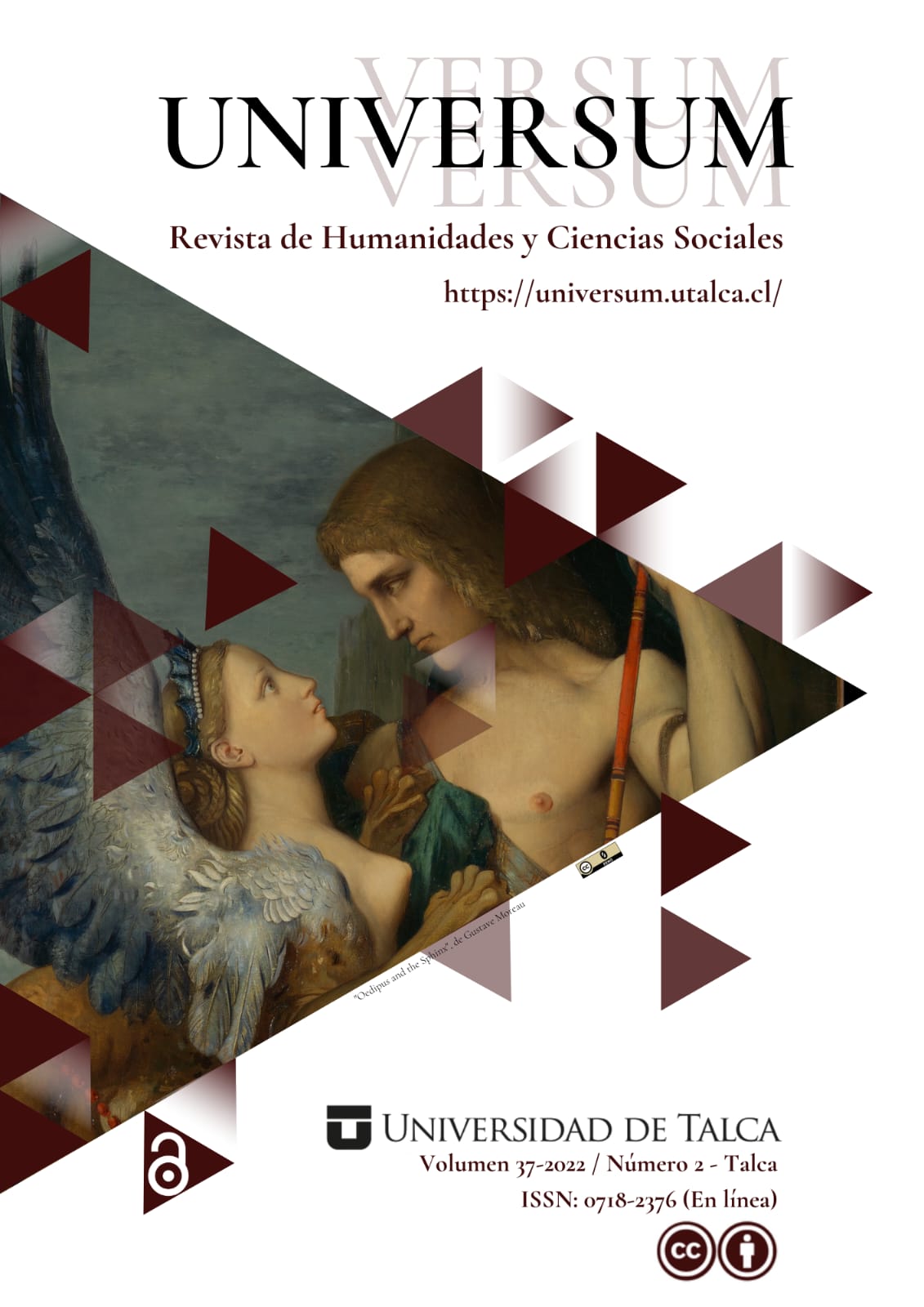Resumen
---
Citas
Arias Maldonado, M. (18 de marzo de 2014). Antropoceno: el fin de la naturaleza. Revista de Libros. https://cutt.ly/uVuJjEn
Bizzarri, H. O. (Ed.). (2018). Monde animal et végétal dans le récit bref du Moyen ge. Colloque international 2016. Reichert.
Caiazzo, I. (2015). Nature et découverte de la nature au XIIe siècle: Nouvelles perspectives. Quaestio, 15, 47–72.
Caiazzo, I. (2020). Filosofia della natura e fisica elementare nell’Alto Medioevo. En La conoscenza scientifica nell’Alto Medioevo. Atti della LXVII Settimana di studio del Centro italiano di studi sull’Alto Medioevo (Vol. 2; pp. 1059–1086). Fondazione Centro Italiano di Studi sull’Alto Medioevo.
Castro Hernández, P. (2015). La naturaleza y el mundo en la Edad Media: Perspectivas teológicas, cosmológicas y maravillosas. Revista Historias del Orbis Terrarum, Anejos de Estudios Clásicos, Medievales y Renacentistas, 10, 1–35.
Clemente Ramos, J. (Ed.). (2001). El medio natural en la España medieval: Actas del I Congreso sobre ecohistoria e historia medieval. Universidad de Extremadura.
Dilg, P. (Ed.). (2003). Natur im Mittelalter: Konzepte - Erfahrungen - Wirkungen. Akademie.
Dillinger, K. (27 de Febrero de 2022). Estudios ofrecen más evidencia de que la pandemia de coronavirus comenzó en animales, en el mercado de Wuhan. CNN Español. https://cutt.ly/oVuJLNE
Draelants, I. (2019). Creation, Generation, Force, Motion, Habit: Medieval Theoretical Definitions of Nature. En F. Bretelle-Establet, M. Gaille y M. Katouzian-Safadi (Eds.), Making sense of health, disease, and the environment in cross-cultural history: The Arabic-Islamic World, China, Europe and North America (pp. 27–60). Springer.
Folena, L. (2017). Contrées sans culture: ‘Nature’ Across the Anthropological Rift. Le Simplegadi, (17), 182–193. https://cutt.ly/JVuKamb
Fuertes Herreros, J. L. y Poncela Gonza?ez, A. (Eds.). (2015). La naturaleza en la Edad Media (2 vols.). Húmus.
Germann, N. (2010). Natural Philosophy in Earlier Latin Thought. En R. Pasnau (Ed.), The Cambridge history of Medieval philosophy (pp. 219–231). Cambridge University Press.
Goetz, H.?W. (2011). Gott und die Welt: Religiöse Vorstellungen des frühen und hohen Mittelalters, Teil 1. Band 2: II. Die materielle Schöpfung: Kosmos und Welt. Akademie.
Goetz, H.?W. (2016). Gott und die Welt: Religiöse Vorstellungen des frühen und hohen Mittelalters, Teil 1. Band 3: IV. Die Geschöpfe: Engel, Teufel, Menschen. V&R Unipress.
Grassi, O. y Catapano, G. (Eds.). (2019). Rappresentazioni della natura nel Medioevo. SISMEL - Edizioni del Galluzzo.
Hanawalt, B. y Kiser, L. J. (Eds.). (2008a). Engaging with nature: Essays on the natural world in medieval and early modern Europe. University of Notre Dame.
Hanawalt, B. y Kiser, L. J. (2008b). Introduction. En B. Hanawalt y L. J. Kiser (Eds.), Engaging with nature: Essays on the natural world in medieval and early modern Europe (pp. 1–10). University of Notre Dame.
Jacquart, D. (2017). La notion de matière dans les commentaries bibliques: Quelques exemples (XIIe-XIVe siècles). En T. Suarez-Nani y A. Paravicini Bagliani (Eds.), Materia: Nouvelles perspectives de recherche dans la pensée et la culture médiévales (XIIe-XVIe siècles) (pp. 3–25). SISMEL - Edizioni del Galluzzo.
Kann, C. (2003). Zeichen-Ordnung-Gesetz: Zum Naturverständnis in der mittelalterlichen Philosophie. En P. Dilg (Ed.), Natur im Mittelalter: Konzepte - Erfahrungen - Wirkungen (pp. 33–49). Akademie.
Kehse, U. (2017). Environmental Sins from Prehistoric Times. Max Planck Research, 3(17), 34-41. https://cutt.ly/lVuKPW7
Koyama, C. (Ed.). (2000). Nature in medieval thought: Some approaches East and West. Brill.
Luchía, C. (Ed.). (2018). Comunidades en conflicto. Élites comunitarias y poder político en la Península Ibérica (siglos IX a XVI). Facultad de Filosofía y Letras de la Universidad de Buenos Aires.
Myers, N. R. (Ed.). (2016). Art and nature in the Middle Ages. Dallas Museum of Art, Yale University.
Obrist, B. (2015). The physical and the spiritual universe: Infernus and paradise in medieval cosmography and its visual representations (seventh-fourteenth century). Studies in Iconography, 36, 41–78. https://cutt.ly/cVuKKxd
Obrist, B. (2020). La cosmologie du Haut Moyen Age, le statut de la connaissance philosophique et la question d’un univers christianisé. En La conoscenza scientifica nell’Alto Medioevo: Atti della LXVII Settimana di studio del Centro italiano di studi sull’Alto Medioevo (Vol. 1; pp. 53–112). Fondazione Centro Italiano di Studi sull’Alto Medioevo.
Organización Mundial de la Salud (29 de julio de 2020). Zoonosis. https://cutt.ly/mVuK1si
Poma, R., Sorokina, M. y Weill-Parot, N. (Eds.). (2021). Les confins incertains de la nature (XIIe-XVIe siècles). Librairie Philosophique J. Vrin.
Ricklin, T. (1998). Der Traum der Philosophie im 12. Jahrhundert: Traumtheorien zwischen Constantinus Africanus und Aristoteles. Brill.
Rucquoi, A. (2007). La percepción de la naturaleza en la alta Edad Media. En F. Sabaté i Curull (Ed.), Natura i desenvolupament: El medi ambient a l’Edat Mitjana (pp. 73–98). Pagès.
Soriano, C. (2020). On the Anthropocene formalization and the proposal by the Anthropocene Working Group. Geologica Acta, 18, 1–10. https://doi.org/10.1344/GeologicaActa2020.18.6
Weill-Parot, N., Ausécache, M., Chandelier, J., Moulinier-Brogi, L. y Nicoud, M. (Eds.). (2019). De l’homme, de la nature et du monde: Mélanges d’histoire des sciences médiévales offerts à Danielle Jacquart. Droz.

Esta obra está bajo una licencia internacional Creative Commons Atribución-NoComercial 4.0.


